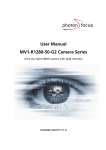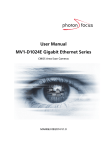Download GEVPlayer Quick Start Guide
Transcript
GEVPlayer Quick Start Guide High-performance imaging data and video over Ethernet. Version 2.0 These products are not intended for use in life support appliances, devices, or systems where malfunction of these products can reasonably be expected to result in personal injury. Pleora Technologies Inc. (Pleora) customers using or selling these products for use in such applications do so at their own risk and agree to indemnify Pleora for any damages resulting from such improper use or sale. Copyright © 2011 Pleora Technologies Inc. All information provided in this manual is believed to be accurate and reliable. No responsibility is assumed by Pleora for its use. Third party copyrights and trademarks are the property of their respective owners. Pleora reserves the right to make changes to this information without notice. Redistribution of this manual in whole or in part, by any means, is prohibited without obtaining prior permission from Pleora. Manual No.: EX001-017-0002 Version 2.0 2/7/11 Contents What this Guide Provides ............................................................................................................................ 3 Related Documents .................................................................................................................................................3 Introduction ................................................................................................................................................. 5 Installing GEVPlayer ...............................................................................................................................................5 System Requirements ......................................................................................................................................5 Launching GEVPlayer .............................................................................................................................................6 Understanding GEVPlayer .....................................................................................................................................6 Comparing Drivers ...................................................................................................................................... 7 Network Stack ..................................................................................................................................................7 eBUS Universal Pro Driver ..............................................................................................................................7 eBUS Universal Driver .....................................................................................................................................7 eBUS Optimal Driver ........................................................................................................................................7 High-Performance Driver .................................................................................................................................7 Using the eBUS Driver Installation Tool ..................................................................................................................8 Introduction ................................................................................................................................................. 9 Pleora IP Engine Devices Support Firewall Compatibility Features ........................................................................9 GigE Vision 1.0 ................................................................................................................................................9 Third-Party Devices .........................................................................................................................................9 Disabling the Windows Vista and Windows 7 Firewall ..........................................................................................10 Disabling the Windows XP Firewall .......................................................................................................................10 Introduction ............................................................................................................................................... 11 Connecting to GigE Vision Devices ......................................................................................................................11 Locating Unreachable Devices .............................................................................................................................12 Configuring a Valid IP Address .............................................................................................................................12 Configuring a Persistent IP Address .....................................................................................................................13 Acquiring Images ..................................................................................................................................................15 Adjusting Images ...................................................................................................................................................15 Saving Images ......................................................................................................................................................15 Understanding Acquisition Modes .........................................................................................................................15 Modes Standard on Most GigE Vision Compliant Devices ............................................................................15 Modes Available on Pleora IP Engines ..........................................................................................................16 Configuring GEVPlayer’s Role ..............................................................................................................................17 Configuring the Stream Destination, Unicast or Multicast ..............................................................................18 Understanding GEVPlayer Control Dialog Boxes .................................................................................................18 Connection Pane: ..........................................................................................................................................19 Acquisition Control Pane ................................................................................................................................19 Display Pane ..................................................................................................................................................20 Using the Control Dialogs .....................................................................................................................................21 Adjusting the Visibility of GEVPlayer Controls ......................................................................................................23 Monitoring Performance ........................................................................................................................................23 Using the Event Monitor ........................................................................................................................................24 Saving Your Device Configuration Settings ..........................................................................................................26 Modifying Camera Parameters Through Serial Ports ............................................................................................26 Configuring the Serial Ports ...........................................................................................................................27 Setting the Baud Rate for Serial Ports ...........................................................................................................27 Pleora Resource Center ............................................................................................................................ 31 Pleora Support Portal ................................................................................................................................ 31 3 About this Guide What this Guide Provides This guide provides you with the information you need to efficiently set up and start using the GEVPlayer software application to control your GigE Vision-compliant video transmitters (cameras) and receivers. In this guide, you can find a product overview, advice about driver selection, instructions for configuring a Windows network firewall, and the steps you can take to configure GEVPlayer to suit your requirements. The last section of this guide provides Technical Support contact information for Pleora Technologies. Related Documents The GEVPlayer Quick Start Guide is complemented by the following guides: • vDisplay HDMI-Pro IP Engine User Manual • Vision SDK to eBUS SDK Migration Guide • SB-Pro Hardware Guide Copyright © 2011 Pleora Technologies Inc. 4 About this Guide Copyright © 2011 Pleora Technologies Inc. 5 About GEVPlayer Introduction GEVPlayer, part of the Pleora Technologies eBUS™ SDK, is a sample application that allows you to control the parameters of GigE Vision devices by providing access to the GenICam-compliant XML files built into all GigE Vision-compliant devices. The XML file provides access to the GigE Vision device features, which are controlled with the GenICam API, and a GenICam node map. GEVPlayer allows you to save GenICam XML information retrieved from a device; you can also load the saved GenICam XML file information to a device. Not just a controller, GEVPlayer also receives and allows you to view streaming data. While viewing the image data, you can use GEVPlayer to adjust the image color and white balance, and save images and device configuration settings. You can use the debugging tools in GEVPlayer to determine the optimal settings for your system. As you become more familiar with GigE Vision and GenICam, you can continue to control your GigE Vision devices using GEVPlayer, or you can build your own software application using the eBUS SDK. NOTE! Ensure that you have installed version 2.0 or higher of the eBUS SDK (formerly called the eBUS PureGEV SDK suite) with GEVPlayer on the PC or laptop. Installing GEVPlayer The GEVPlayer application is installed with the eBUS SDK. Follow the standard installation instructions to install the eBUS SDK on your PC. NOTE! If you do not have the CD, you can access installation files from the Pleora Resource Center at www.Pleora.com. System Requirements Ensure the computer or laptop on which you install the eBUS SDK, meets the following recommended requirements: • A 32 bit or 64 bit (or higher) processor • At least one Gigabit Ethernet NIC • One of the following operating systems: •Microsoft® Windows® 7, 32 bit or 64 bit •Microsoft® Windows® XP with Service Pack 3 or higher 32 bit or 64 bit •Microsoft® Windows® Vista, SP 3 or higher, 32 bit or 64 bit •Red Hat Enterprise Linux 5.4 32 bit or 64 bit •OpenSUSE 11.3. NOTE! If you use the Linux operating, you must run the installation software as Root. NOTE! The instructions included in this document are based on the assumption that GEVPlayer is installed on a Windows operating system. Instructions may vary depending on the exact UI configuration of your Windows OS installation. Copyright © 2011 Pleora Technologies Inc. 6 About GEVPlayer Launching GEVPlayer You can launch GEVPlayer from the Windows Start menu. To launch GEVPlayer 1. Click Start / All Programs / Pleora Technologies Inc / eBUS SDK / GEVPlayer. Understanding GEVPlayer The main screen of GEVPlayer consists of two main panels. You can select, connect to, and acquire images from your GigE Vision device using the functions in the Connection panel the left side of the main screen, and you can view video in the Display panel on the right side of the main screen. NOTE! For more detailed information about how to use GEVPlayer to control your GigE Vision devices, please see “Controlling GigE Vision Devices” on page 11. Copyright © 2011 Pleora Technologies Inc. 7 Choosing a Driver Comparing Drivers The eBUS SDK provides you with drivers you can install to optimize system performance. The available Pleora drivers are installed from the eBUS Driver Installation Tool, which is located in the Pleora Technologies Installation directory. NOTE! Pleora drivers are not automatically installed when you install the eBUS SDK. If you choose not to install one of the Pleora drivers, you can use the NIC manufacturer’s driver available on your computer or laptop. Network Stack You can use the network stack on your computer or laptop when it is not desirable or possible for you to install a driver. The network stack offers acceptable performance in most scenarios, but consumes greater processor resources during operation and throughput may be limited. eBUS Universal Pro Driver The eBUS Universal Driver Pro driver offers the best performance and excellent compatibility with most network adaptors. You cannot not use it with the legacy Vision SDK. eBUS Universal Driver The eBUS Universal driver is a legacy driver that can only be deployed on workstations using the legacy Vision SDK. The eBUS Universal driver is compatible with most network adapters. eBUS Optimal Driver The eBUS Optimal Driver is Pleora’s legacy driver, recommended for use only on workstations where the legacy Vision SDK is in use. The eBUS Optimal Driver is compatible with network adapters using specific Intel Pro/1000 chipsets only. High-Performance Driver The High-Performance driver is a legacy driver for use with applications using the legacy Vision SDK. The High-Performance driver is compatible with network adapters using specific Intel Pro/1000 chipsets and can be used only with devices supporting the Pleora protocol. NOTE! The eBUS Universal, eBUS Optimal, and the High-Performance driver are only available if you have installed the Vision SDK. For more detailed driver installation and compatibility information, please refer to the “Vision SDK to eBUS SDK Migration Guide.” Copyright © 2011 Pleora Technologies Inc. 8 Choosing a Driver Using the eBUS Driver Installation Tool The list of available Pleora drivers is located in the eBUS Driver Installation Tool. To install a Pleora driver, first open the eBUS Driver Installation Tool from the Pleora Technologies Installation directory. To install a Pleora driver: 1. 2. 3. 4. 5. Click Start / All Programs / Pleora Technologies Inc / eBUS SDK / Tools / Driver Installation Tool. From the list, identify the NIC(s) you want to use to connect to your GEV device(s). In the Action column of the eBUS Driver Installation Tool, click the arrow in the drop-box to select the appropriate driver installation option. Click Install. Click Close. Copyright © 2011 Pleora Technologies Inc. 9 Configuring Firewalls Introduction Some third-party GigE Vision devices do not support the optional features introduced in version 1.1 and above of the GigE Vision standard that ensure compatibility with firewalls. This restriction requires you to disable the PC firewall to properly use devices not supporting the optional features. This section provides you with instructions for disabling the firewall in the Windows XP, Windows Vista, or Windows 7 operating systems. NOTE! For more detailed information about how firewalls function, including how firewalls can affect GigEVision devices, see the Pleora Technologies Technical Note, “Correcting Firewall Issues with 3rd Party GigE Vision Devices” available on the Pleora Resource Center at www.pleora.com. Pleora IP Engine Devices Support Firewall Compatibility Features Pleora GigE Vision devices support the firewall compatibility features introduced in versions 1.1 and above of the GigE Vision standard. These features allow devices to report the device-side UDP ports they use for streaming and messaging channels. This reporting feature allows the SDK to know exactly where to send the packets used to keep the firewall open. The eBUS SDK operates correctly with Windows firewalls when used with Pleora GigE Vision devices. You should not have to lower the firewall or take any specific action. GigE Vision 1.0 GigE Vision 1.0 does not provide any standard device-side UDP port side reporting mechanism. However, because Pleora developed both the eBUS SDK and the iPORT IP Engines, the device-side UDP port numbers used by the IP engines are known to the SDK. When the eBUS SDK is used with a Pleora IP Engine, it knows where to send the packets to keep the firewall open. For streaming, the device uses port 20202 + channel number. The streaming channel 0 (first, default) uses port 20202. For the messaging channel, the device uses port 4. Third-Party Devices As mentioned preciously, version 1.1 of the GigE Vision standard added optional features allowing devices to report which device-side UDP port is used for streaming each available streaming channel, and for the messaging channel. This mechanism allows the eBUS SDK to know exactly where to send the packet used to keep the firewall open. It is important to understand that this GigE Vision 1.1 feature is optional. Not all third-party devices support it, even if they report using GigE Vision 1.1, or above. If your third-party devices support the firewall compatibility features, your system should work without having to disable the firewall. If your third-party devices do not support the firewall compatibility features, the firewall needs to be deactivated in order for your system to stream, or use the messaging channel. Copyright © 2011 Pleora Technologies Inc. 10 Configuring Firewalls Disabling the Windows Vista and Windows 7 Firewall This section provides you with the steps to take to disable the Windows Vista and Windows 7 Firewall. In both the Windows Vista and Windows 7 operating systems, you can control the firewall setting for domain networks (corporate); home or private networks (behind a secured router, such as a home or SOHO network); or, a public network. We recommend that you do not deactivate the firewall on a public network; for example, a wireless access point at a coffee house, or hotel. If you are on a corporate or home network, but Windows behaves as if you are on a public network, you might need to set the correct type of network used by your NIC. To set your network type: 1. 2. 3. 4. 5. Click Start / Control Panel. Click Network and Internet. Click Network and Sharing Center. Adjust the network settings. Close the Control Panel. To disable the Windows Vista and Windows 7 Firewall: 1. 2. 3. 4. 5. 6. Click Start / Control Panel. Click System and Security. Click Windows Firewall. In the Control Panel Home, click Turn Windows Firewall On or Off. Select Turn Off Windows Firewall for the appropriate network locations. Close the Control Panel. Disabling the Windows XP Firewall Unlike the Windows Vista or Windows 7 operating systems, Windows XP does not allow you to configure the firewall for different types of networks. There is only one master control. To disable the Windows XP Firewall: 1. 2. 3. 4. Click Start / Control Panel. Click Windows Firewall. On the General tab, click Off. Click OK. Copyright © 2011 Pleora Technologies Inc. 11 Controlling GigE Vision Devices Introduction After you have assembled and powered up the GigE Vision compliant devices in your video network system, you can connect to and adjust the settings of the devices using the GEVPlayer application. Connecting to GigE Vision Devices It is important for GEVPlayer to be installed on a PC or laptop that is connected to the same subnet as the GigE Vision device to which you want to connect. If GEVPlayer and the GigE Vision device are not on the same subnet, the device might not appear within the GEVPlayer application. To connect to a GigE Vision device: 1. 2. Click Start / All Programs / Pleora Technologies Inc / eBUS SDK / GEVPlayer. In the Connection pane, click Select / Connect 3. Click to select the GigE Vision device in the Available GigE Vision Devices window. 4. Click OK. Copyright © 2011 Pleora Technologies Inc. 12 Controlling GigE Vision Devices Locating Unreachable Devices If your device does not appear in the Available GigE Vision Devices list, possibly because the device IP configuration, and IP configuration of the GEVPlayer PC NIC are not on the same subnet, you can locate the device by clicking “Show unreachable GigE Vision Devices”, as shown in the image below: Configuring a Valid IP Address If the GigE Vision device does not have a valid IP address, an error message appears, as shown in the image below: Copyright © 2011 Pleora Technologies Inc. 13 To configure a valid IP address: NOTE! This procedure allows you to set a valid IP address, but not a persistent IP address for the GigE Vision device. See “To configure a persistent IP address:” if you want the IP address to be permanently used on the GigE Vision device. 1. Start GEVPlayer and click Select / Connect. 2. 3. 4. Click to select the GigE Vision device in the Available GigE Vision Devices window. Click Set IP Address in the bottom left corner. In the Set IP Address box, enter a valid IP address, Subnet Mask, and Default Gateway. The red exclamation mark disappears if the IP address is valid. 5. Click OK. Configuring a Persistent IP Address By default, IP engines are configured to automatically acquire an IP address using Dynamic Host Configuration Protocol (DHCP) and Link Local Addresses (LLA), provided no persistent IP address has been assigned. This allows you to immediately connect to the IP engine at first-time deployment, and then, if you choose to, provide it with a persistent IP address. If you provide the IP engine with a persistent IP address, it will use this persistent IP address each time it is powered up and connected to the network. NOTE! The IP engine can use the persistent IP address each time it is powered up as long as the IP address is valid and there were no IP address conflicts at the time the IP address was configured. To configure a persistent IP address: 1. 2. 3. 4. 5. 6. Start GEVPlayer and click Select / Connect. Click to select the IP engine in the Available GigE Vision Devices window. Click OK in the bottom right corner. Click GEV Device control in the Parameters and Controls section. In the TransportLayerControl section of the GEV Device Control dialog box, enter a subnet mask in the GevPersistentSubnetMask box. Enter a default gateway in the GevPersistentDefaultGateway box. NOTE! The subnet gateway value can remain at 0. Copyright © 2011 Pleora Technologies Inc. 14 Controlling GigE Vision Devices 7. Click in the GEVCurrentIPConfigurationPersistentIP box and select True. 8. Enter the persistent IP address in the GEVPersistentIPAddress box. 9. Close the GEV Device Control dialog box. NOTE! The IP engine uses the persistent IP address first, but if this option if set to False, it uses the IP address provided by DHCP next, and if this fails, uses LLA to find an available IP address. LLA cannot be disabled and is True by default. Copyright © 2011 Pleora Technologies Inc. 15 Acquiring Images The Acquisition Control panel lets you access the features that control how you acquire images. The GigE Vision Standard requires that your GigE Vision compliant transmitter start up in a state ready to send images. You can acquire images even if you don’t have a camera — Pleora iPORT IP engines send a sawtooth-shaped test pattern by default. To acquire images: 1. 2. Start GEVPlayer and click Select / Connect. In the Acquisition Control section of the Connection pane, select your preferred Mode and Channel. For continuous images, select Continuous and Data Channel #0. For other acquisition modes, see “Understanding Acquisition Modes” on page 15. 3. Click Play. The images appear in the Display pane. Adjusting Images GEVPlayer provides you with tools to adjust your images. To zoom the image in or out: • Right-click the image and select a zoom setting from the context menu. To adjust the image color • Select Tools / Image Filtering. Saving Images GEVPlayer allows you to save acquired images as well as your configuration settings. To save images: • Select Tools / Save Images. To save GEVPlayer and IP engine settings to disk: • Select File / Save. Understanding Acquisition Modes Depending on the device you use, GEVPlayer provides you with a list of image acquisition modes. The modes allow you to acquire images continuously, or frame-by-frame. You can also save images to the Pleora IP engine’s onboard memory so that you can retrieve them later. Modes Standard on Most GigE Vision Compliant Devices The following modes are usually standard for IP engines: Continuous This mode allows you to acquire images continuously and is the default GEVPlayer mode. Copyright © 2011 Pleora Technologies Inc. 16 Controlling GigE Vision Devices Multiframe This mode allows you to acquire a fixed number of images. To configure the number of images, you must set the IP engine’s AcquisitionFrameCount feature. NOTE! You can set IP the IP engine’s AcquisitionFrameCount feature in the GEV Device Control dialog box, as shown in the following image: SingleFrame This mode allows you to acquire a single image. Modes Available on Pleora IP Engines The following additional acquisition modes are available on Pleora IP engines and may also be available on third-party IP engines: ContinuousReadout This mode allows you to acquire images continuously from the IP engine’s onboard memory (until all images in memory have been retrieved). ContinuousRecording This mode allows you to save images to the IP engine’s onboard memory until the memory is full. SingleFrameReadout This mode allows you to acquire a single image from the IP engine’s onboard memory. SingleFrameRecording This mode allows you to save a single image to the IP engine’s onboard memory. Copyright © 2011 Pleora Technologies Inc. 17 Configuring GEVPlayer’s Role The first time you start GEVPlayer and connect to an IP engine, the following GEVPlayer role error message may appear: By default, GEVPlayer acts as a controller and data receiver. However, when connecting to some IP engines, such as the Pleora vDisplay IP engine, GEVPlayer must be configured as a controller only and not as a data receiver. The vDisplay IP engine transmits video data to a display monitor only and not to the GigE Vision network. The GEVPlayer roles are configured in the Setup dialog, shown in the image below: To access the Setup dialog: • Start GEVPlayer and select Tools / Setup. Table 4: GEVPlayer Roles Role Description Controller and data receiver Select this role if you are using GEVPlayer to connect to and control a GigE Vision-compliant transmitter device AND if you want GEVPlayer to receive streaming video from the device. Select this role if you are using GEVPlayer to connect to and control a GigE Vision-compliant device. GEVPlayer does not receive streaming video from the device if this option is selected. Controller Copyright © 2011 Pleora Technologies Inc. 18 Controlling GigE Vision Devices Role Description Data Receiver Select this role if you are using GEVPlayer to connect to and receive streaming video from a GigE Vision-compliant device. You cannot control the device if this option is selected. Select this role if you are using GEVPlayer to view the parameters and settings of a GigE Vision-compliant device. You cannot make any changes to the device parameters or view video if this option is selected. Monitor Configuring the Stream Destination, Unicast or Multicast The Stream Destination pane is located beside the GEVPlayer Role pane and provides options that allow you to configure GigE Vision-compliant video sources to operate in either a unicast or multicast video network configuration. Table 5: Stream Destination Options Option Description Unicast, automatic Select this option to configure the camera to stream video directly to the GEVPlayer PC using an automaticallyselected port. Select this option to configure the camera to stream video directly to a user-defined port on the GEVPlayer PC. Select this option to configure the camera to stream video directly to a PC or a vDisplay IP engine (a destination other than the GEVPlayer PC). Select this option to configure the camera to join a multicast group (specified by the IP address and port), and to begin streaming to that group. The vDisplay IP engine, or any other receiver such as a PC, must be configured to receive streaming video at the same multicast address. If GEVPlayer is configured as a multicast receiver, it allows you to view video from the camera streaming video to the same multicast address. Unicast, specific local port Unicast, other destination Multicast Understanding GEVPlayer Control Dialog Boxes The features of the IP engine are parameter based. By changing the values of controls in the GEVPlayer control dialog boxes, you can affect how the IP engine performs. GEVPlayer breaks system configuration into the following three categories and provides a set of controls for each category in a separate dialog box: • Communication Control dialog box: Controls connection and communication settings between host PC and IP engine. • GEV Device Control dialog box: Controls all device settings including transport layer settings; image processing settings; image mode and formatting settings; display timing settings; channel settings; autonomous control settings; and messaging settings. • Image Stream Control dialog box: Controls image stream settings and provides performance statistics. NOTE! Some of the features in the control dialog boxes are also shown in the GEVPlayer user interface. Copyright © 2011 Pleora Technologies Inc. 19 Connection Pane: The following table shows the relationship between controls in the GEV Device Control dialog box and the controls in the Connection pane: Table X: Connection Pane Controls and GEV Control Dialog Box Connection Pane Control Feature in GEV Device Control Dialog Box IP address field MAC address field Manufacturer field Model field TransportLayerControl / GevCurrentIPAddress TransportLayerControl / GevMACAddress DeviceControl / DeviceVendorName DeviceControl / DeviceModelName Acquisition Control Pane The following table shows the relationship between controls in the GEV Control dialog box and the controls in the Acquisition Control pane: Table X: Acquisition Control Pane Controls and GEV Control Dialog Box Acquisition Control Pane Control Feature in GEV Device Control Dialog Box Mode drop-down box Channel drop-down box Play button Stop button AquisitionControl / AcquisitionMode TransportLayerControl / GevStreamChannelSelector AquisitionControl / AcquisitionStart AquisitionControl / AcquisitionStop Copyright © 2011 Pleora Technologies Inc. 20 Controlling GigE Vision Devices NOTE! You should stop and start image acquisition using the controls in the Acquisition Control pane and not the controls in the GEV Device Control dialog box. Doing so can lead to configuration information being out of date. Display Pane The following table shows the relationship between controls in the GEV Control dialog box and the controls in the Display pane: Table X: Display Pane Controls and Image Stream Control Dialog Box Display Pane Control Feature in Image Stream Control Dialog Box Image count (nnn images) Frame rate (xxxFPS) Data Rate (yyy Mbps) Statistics / General / BlockCount Statistics / General / AcquisitionRateAverage Statistics / General / BandwidthAverage Copyright © 2011 Pleora Technologies Inc. 21 To access the Control dialog boxes: 1. 2. Start GEVPlayer and click Select / Connect. Click to select the GigE Vision device in the Available GigE Vision Devices window. 3. 4. Click OK in the bottom right corner. Click either GEV Device control, or Communication Control, or Image Stream Control in the Parameters and Controls section. Using the Control Dialogs The IP engine features are listed in the control dialog boxes. You can expand each main feature category to view all of the parameter controls. You can also view the features alphabetically so that they are easier to find. Copyright © 2011 Pleora Technologies Inc. 22 Controlling GigE Vision Devices To expand or collapse the list of feature controls: • Click the + or - icons. To view the features alphabetically: • Click the alphabetization icon. Copyright © 2011 Pleora Technologies Inc. 23 Adjusting the Visibility of GEVPlayer Controls You can adjust the number of controls available to you to suit your level of video network responsibility and understanding. There are more controls available for the Guru level than for the Beginner level; some controls are not available in the Beginner level. To adjust the visibility of controls: 1. 2. 3. 4. 5. Start GEVPlayer and click Select / Connect. Click to select the vDisplay IP engine in the Available GigE Vision Devices window. Click OK in the bottom right corner. Click either GEV Device control or Communication Control in the Parameters and Controls section. Using the GEV Device Control dialog box as an example, click the arrow in the Visibility dropdown box and select the appropriate user level. Monitoring Performance As your IP engine receives images from your camera and sends them to your PC, it keeps track of image errors such as missing lines, network errors such as lost packets, and other performance-related statistics. Copyright © 2011 Pleora Technologies Inc. 24 Controlling GigE Vision Devices You can view a complete list of error counts in the Image Stream Control dialog. Performance metrics are grouped in the Statistics folder. You can view a summarized list of error counts at the bottom of the Display pane. The pane shows the total number of images displayed (BlockCount), the instantaneous frame rate (AcquisitionRateAverage), and the data rate (BandwidthAverage). Using the Event Monitor The Event Monitor is a valuable tool you can use to determine causes of any issues that may occur during the use of you IP engine. If enabled, you can view time-stamped records of all GenICam parameter updates, PV Stream buffer errors as well as the successful PV Stream buffers. You can clear the log content, and you can save the content to your hard drive. Copyright © 2011 Pleora Technologies Inc. 25 To access the Event Monitor: 1. 2. Start GEVPlayer and connect to your IP engine. Select the IP engine in the Available GigE Vision Devices window. 3. 4. 5. Click OK. Click Play. Click Tools / Event Monitor. To view GenICam parameter updates: 1. 2. Open the Event Monitor. Click the GenICam parameters updates check box. To view PVStream buffer errors 1. 2. Open the Event Monitor. Click the PVStream buffers (errors) check box. To view successful PVStream buffers along with PVStream buffer errors: 1. 2. Open the Event Monitor. Click the PVStream buffers (all) check box. To save events in the monitor: 1. 2. Open the Event Monitor. Click Save to file and browse to the desired location. Copyright © 2011 Pleora Technologies Inc. 26 Controlling GigE Vision Devices Saving Your Device Configuration Settings You can use the options available in the UserSetControl section of the GEV Device Control dialog box to save the changes you make to your IP engine settings. Once saved, the changes, saved as “user sets” can persist across power cycles. Currently, the IP engine supports two user sets: UserSet1, which consists of the user configured settings, and Default, which consists of the pre-configured settings, to which you can always revert. Settings identified as Default in the GEV Device Control dialog box cannot be changed. The following table describes the options available in UserSetControl: Table 9: Saving Configuration Options Setting Description UserSetSelector UserSetLoad Selects the feature User Set to load, save or configure. Loads the User Set specified by UserSetSelector to the device and makes it active. Saves configuration data to User Set specified by UserSetSelector, which is part of the non-volatile memory of the device. Selects the feature User Set to load and make active when the device is reset. Shows the last user set executed by the IP engine from a UserSetLoad command, or as a result of a reset of the IP engine. This option indicates the success or failure of the last user set applied. The user set can be applied through a power cycle or through user selection. UserSetSave UserSetDefaultSelector UserSetLoadLastUserSet UserSetLoadStatus To save a configuration change to UserSet1: 1. 1. 2. In the GEV Device Control dialog box, make appropriate configuration changes. Scroll to the UserSetControl section and change the UserSetSelector setting to UserSet1. Click UserSetSave. To load the default configuration settings: 1. 2. In the UserSetControl section of the GEV Device Control dialog box, select Default in the UserSetSelector box. Click the UserSetLoad setting and then click the UserSetLoad button that appears to the right. The default settings are applied to the IP engine. Modifying Camera Parameters Through Serial Ports You might want to communicate with a camera, or other external devices through serial ports connected to your Pleora IP engine. GEVPlayer allows you to control the serial ports of a GigE Vision camera that is integrated with a Pleora IP engine. Copyright © 2011 Pleora Technologies Inc. 27 Configuring the Serial Ports The controls to configure the serial ports are available in the GEV Device Control dialog box, as shown below: Setting the Baud Rate for Serial Ports You must set the baud rate for the serial ports if the default value is not acceptable. To set the baud rate for serial ports: 1. 2. 3. Start GEVPlayer and connect to your camera. Click the GEV Device Control button to open the GEV Device Control dialog. Scroll to the PortCommunication section. Ensure you are using the Guru visibility level. 4. In the Uart0 section, set the baud rate using the Uart0BaudRate control. Copyright © 2011 Pleora Technologies Inc. 28 Controlling GigE Vision Devices 5. In the Uart1 section, set the baud rate using the Uart1BaudRate control 6. Close GEVPlayer. NOTE! Other settings, such as parity and the number of stop bits, for example, should also be configured by entering the appropriate values for the settings in the PortCommunication section. To send and receive video using IP Engine serial ports: 1. Start GEVPlayer and select Tools / IP Engine Serial Communication. Copyright © 2011 Pleora Technologies Inc. 29 2. In the Port Selection drop-down box, select Serial0 or Serial1. 3. In the Send pane, select the data transmission sequence format by selecting either ASCII (text only) or Hexadecimal. For hexadecimal, enter a pair of hexadecimal digits for each byte, separated by spaces. 4. 5. Enter the data string in the Data field. Select one of the trailer options in the Append section. Trailer options are not mutually exclusive; they append in the order shown. Select Other for ASCII and hexadecimal sequences in custom trailers for camera heads that do not use the trailer options in the order shown, for example, CR and LF). 6. 7. 8. Click Send to transmit the data sequence. Wait for the camera head to reply. Close the IP Engine Serial Communication window. Copyright © 2011 Pleora Technologies Inc. 30 Controlling GigE Vision Devices Copyright © 2011 Pleora Technologies Inc. 31 Technical support Pleora Resource Center At the Resource Center, you can: • Download the latest software. • View documentation for current and past releases. • Get presentations and application notes. • Get the latest news and information about our products. • Decide which of Pleora’s products work best for you. To visit the Resource Center: 1. 2. Go to www.pleora.com/ and click Resource Center. If you have not previously logged in, you are prompted to register. Accounts are usually validated within one business day. Pleora Support Portal At the Support Portal, you can: • Browse for solutions to problems other customers have encountered. • Log a support issue. To visit the Support Portal: 1. 2. Go to www.pleora.com and click Help & Support. If you haven’t logged in before, you are prompted to register. Accounts are usually validated within one business day. If you can’t find an existing solution in the knowledge base, post a question by clicking Log a Case. Provide as many specific details about your system and the nature of the issue as possible. Copyright © 2011 Pleora Technologies Inc. 32 Technical support Copyright © 2011 Pleora Technologies Inc.

























































